Milankovitch cycles
Milankovitch cycles describe the collective effects of changes in the Earth's movements on its climate over thousands of years. The term is named for Serbian geophysicist and astronomer Milutin Milanković. In the 1920s, he hypothesized that variations in eccentricity, axial tilt, and precession resulted in cyclical variation in the solar radiation reaching the Earth, and that this orbital forcing strongly influenced climatic patterns on Earth.

• Graphic shows variations in five orbital elements: Axial tilt or obliquity (ε). Eccentricity (e). Longitude of perihelion ( sin(ϖ) ). Precession index ( e sin(ϖ) ) • Precession index and obliquity control insolation at each latitude: Daily-average insolation at top of atmosphere on summer solstice () at 65° N • Ocean sediment and Antarctic ice strata record ancient sea levels and temperatures: Benthic forams (57 widespread locations) Vostok ice core (Antarctica) • Vertical gray line shows present (2000 CE)
Similar astronomical hypotheses had been advanced in the 19th century by Joseph Adhemar, James Croll and others, but verification was difficult because there was no reliably dated evidence, and because it was unclear which periods were important.
Now, materials on Earth that have been unchanged for millennia (obtained via ice, rock, and deep ocean cores) are being studied to indicate the history of Earth's climate. Though they are consistent with the Milankovitch hypothesis, there are still several observations that the hypothesis does not explain.
Earth's movements
The Earth's rotation around its axis, and revolution around the Sun, evolve over time due to gravitational interactions with other bodies in the Solar System. The variations are complex, but a few cycles are dominant.[1]
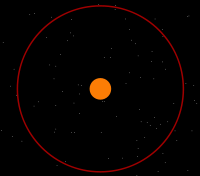
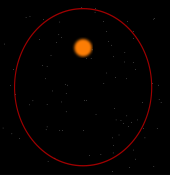
The Earth's orbit varies between nearly circular and mildly elliptical (its eccentricity varies). When the orbit is more elongated, there is more variation in the distance between the Earth and the Sun, and in the amount of solar radiation, at different times in the year.
In addition, the rotational tilt of the Earth (its obliquity) changes slightly. A greater tilt makes the seasons more extreme. Finally, the direction in the fixed stars pointed to by the Earth's axis changes (axial precession), while the Earth's elliptical orbit around the Sun rotates (apsidal precession). The combined effect is that proximity to the Sun occurs during different astronomical seasons.
Milankovitch studied changes in these movements of the Earth, which alter the amount and location of solar radiation reaching the Earth. This is known as solar forcing (an example of radiative forcing). Milankovitch emphasized the changes experienced at 65° north due to the great amount of land at that latitude. Land masses change temperature more quickly than oceans, because of the mixing of surface and deep water and the fact that soil has a lower volumetric heat capacity than water.
Orbital eccentricity
The Earth's orbit approximates an ellipse. Eccentricity measures the departure of this ellipse from circularity. The shape of the Earth's orbit varies between nearly circular (with the lowest eccentricity of 0.000055) and mildly elliptical (highest eccentricity of 0.0679).[2] Its geometric or logarithmic mean is 0.0019. The major component of these variations occurs with a period of 413,000 years (eccentricity variation of ±0.012). Other components have 95,000-year and 125,000-year cycles (with a beat period of 400,000 years). They loosely combine into a 100,000-year cycle (variation of −0.03 to +0.02). The present eccentricity is 0.017 and decreasing.
Eccentricity varies primarily due to the gravitational pull of Jupiter and Saturn. However, the semi-major axis of the orbital ellipse remains unchanged; according to perturbation theory, which computes the evolution of the orbit, the semi-major axis is invariant. The orbital period (the length of a sidereal year) is also invariant, because according to Kepler's third law, it is determined by the semi-major axis.
Effect on temperature
The semi-major axis is a constant. Therefore, when Earth's orbit becomes more eccentric, the semi-minor axis shortens. This increases the magnitude of seasonal changes.[3]
The relative increase in solar irradiation at closest approach to the Sun (perihelion) compared to the irradiation at the furthest distance (aphelion) is slightly larger than four times the eccentricity. For Earth's current orbital eccentricity, incoming solar radiation varies by about 6.8%, while the distance from the Sun currently varies by only 3.4% (5.1 million km or 3.2 million mi or 0.034 au).
Perihelion presently occurs around January 3, while aphelion is around July 4. When the orbit is at its most eccentric, the amount of solar radiation at perihelion will be about 23% more than at aphelion. However, the Earth's eccentricity is always so small that the variation in solar irradiation is a minor factor in seasonal climate variation, compared to axial tilt and even compared to the relative ease of heating the larger land masses of the northern hemisphere.
Effect on lengths of seasons
| Year | Northern Hemisphere |
Southern Hemisphere |
Date: UTC | Season duration |
|---|---|---|---|---|
| 2005 | Winter solstice | Summer solstice | 21 December 2005 18:35 | 88.99 days |
| 2006 | Spring equinox | Autumn equinox | 20 March 2006 18:26 | 92.75 days |
| 2006 | Summer solstice | Winter solstice | 21 June 2006 12:26 | 93.65 days |
| 2006 | Autumn equinox | Spring equinox | 23 September 2006 4:03 | 89.85 days |
| 2006 | Winter solstice | Summer solstice | 22 December 2006 0:22 | 88.99 days |
| 2007 | Spring equinox | Autumn equinox | 21 March 2007 0:07 | 92.75 days |
| 2007 | Summer solstice | Winter solstice | 21 June 2007 18:06 | 93.66 days |
| 2007 | Autumn equinox | Spring equinox | 23 September 2007 9:51 | 89.85 days |
| 2007 | Winter solstice | Summer solstice | 22 December 2007 06:08 |
The seasons are quadrants of the Earth's orbit, marked by the two solstices and the two equinoxes. Kepler's second law states that a body in orbit traces equal areas over equal times; its orbital velocity is highest around perihelion and lowest around aphelion. The Earth spends less time near perihelion and more time near aphelion. This means that the lengths of the seasons vary.
Perihelion currently occurs around January 3, so the Earth's greater velocity shortens winter and autumn in the northern hemisphere. Summer in the northern hemisphere is 4.66 days longer than winter, and spring is 2.9 days longer than autumn.
Greater eccentricity increases the variation in the Earth's orbital velocity. However, currently, the Earth's orbit is becoming less eccentric (more nearly circular). This will make the seasons more similar in length.

Axial tilt (obliquity)
The angle of the Earth's axial tilt with respect to the orbital plane (the obliquity of the ecliptic) varies between 22.1° and 24.5°, over a cycle of about 41,000 years. The current tilt is 23.44°, roughly halfway between its extreme values. The tilt last reached its maximum in 8,700 BCE. It is now in the decreasing phase of its cycle, and will reach its minimum around the year 11,800 CE.
Increased tilt increases the amplitude of the seasonal cycle in insolation, providing more solar radiation in each hemisphere's summer and less in winter. However, these effects are not uniform everywhere on the Earth's surface. Increased tilt increases the total annual solar radiation at higher latitudes, and decreases the total closer to the equator.
The current trend of decreasing tilt, by itself, will promote milder seasons (warmer winters and colder summers), as well as an overall cooling trend. Because most of the planet's snow and ice lies at high latitude, decreasing tilt may encourage the onset of an ice age for two reasons: There is less overall summer insolation, and also less insolation at higher latitudes, which melts less of the previous winter's snow and ice.
Axial precession
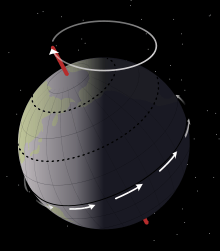
Axial precession is the trend in the direction of the Earth's axis of rotation relative to the fixed stars, with a period of 25,771.5 years. This motion means that eventually Polaris will no longer be the north pole star. It is caused by the tidal forces exerted by the Sun and the Moon on the solid Earth; both contribute roughly equally to this effect.
Currently, perihelion occurs during the southern hemisphere's summer. This means that solar radiation due to (1) axial tilt inclining the southern hemisphere toward the Sun and (2) the Earth's proximity to the Sun, both reach maximum during the southern summer and both reach minimum during the southern winter. Their effects on heating are thus additive, which means that seasonal variation in irradiation of the southern hemisphere is more extreme. In the northern hemisphere, these two factors reach maximum at opposite times of the year: The north is tilted toward the Sun when the Earth is furthest from the Sun. The two effects work in opposite directions, resulting in less extreme variations in insolation.
In about 13,000 years, the north pole will be tilted toward the Sun when the Earth is at perihelion. Axial tilt and orbital eccentricity will both contribute their maximum increase in solar radiation during the northern hemisphere's summer. Axial precession will promote more extreme variation in irradiation of the northern hemisphere and less extreme variation in the south.
When the Earth's axis is aligned such that aphelion and perihelion occur near the equinoxes, axial tilt will not be aligned with or against eccentricity.
Apsidal precession

In addition, the orbital ellipse itself precesses in space, in an irregular fashion, completing a full cycle every 112,000 years relative to the fixed stars.[5] Apsidal precession occurs in the plane of the ecliptic and alters the orientation of the Earth's orbit relative to the ecliptic. This happens primarily as a result of interactions with Jupiter and Saturn. Smaller contributions are also made by the sun's oblateness and by the effects of general relativity that are well known for Mercury.
Apsidal precession combines with the 25,771.5-year cycle of axial precession (see above) to vary the position in the year that the Earth reaches perihelion. Apsidal precession shortens this period to 23,000 years on average (varying between 20,800 and 29,000 years).[5]
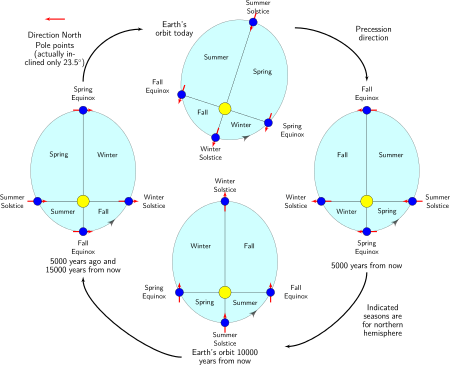
As the orientation of Earth's orbit changes, each season will gradually start earlier in the year. Precession means the Earth's nonuniform motion (see above) will affect different seasons. Winter, for instance, will be in a different section of the orbit. When the Earth's apsides (extremes of distance from the sun) are aligned with the equinoxes, the length of spring and summer combined will equal that of autumn and winter. When they are aligned with the solstices, the difference in the length of these seasons will be greatest.
Orbital inclination
The inclination of Earth's orbit drifts up and down relative to its present orbit. This three-dimensional movement is known as "precession of the ecliptic" or "planetary precession". Earth's current inclination relative to the invariable plane (the plane that represents the angular momentum of the Solar System, approximately the orbital plane of Jupiter) is 1.57°.
Milankovitch did not study planetary precession. It was discovered more recently and measured, relative to Earth's orbit, to have a period of about 70,000 years. However, when measured independently of Earth's orbit, but relative to the invariable plane, precession has a period of about 100,000 years. This period is very similar to the 100,000-year eccentricity period. Both periods closely match the 100,000-year pattern of glacial events.[6]
Theory constraints

Materials taken from the Earth have been studied to infer the cycles of past climate. Antarctic ice cores contain trapped air bubbles whose ratios of different oxygen isotopes are a reliable proxy for global temperatures around the time the ice was formed. Study of this data concluded that the climatic response documented in the ice cores was driven by northern hemisphere insolation as proposed by the Milankovitch hypothesis.[7]
Analysis of deep-ocean cores and of lake depths,[8][9] and a seminal paper by Hays, Imbrie, and Shackleton[10] provide additional validation through physical evidence. Climate records contained in a 1,700 ft (520 m) core of rock drilled in Arizona show a pattern synchronized with Earth's eccentricity, and cores drilled in New England match it, going back 215 million years.[11]
100,000-year issue
Of all the orbital cycles, Milankovitch believed that obliquity had the greatest effect on climate, and that it did so by varying the summer insolation in northern high latitudes. Therefore, he deduced a 41,000-year period for ice ages.[12][13] However, subsequent research[10][14][15] has shown that ice age cycles of the Quaternary glaciation over the last million years have been at a period of 100,000 years, which matches the eccentricity cycle.
Various explanations for this discrepancy have been proposed, including frequency modulation[16] or various feedbacks (from carbon dioxide, cosmic rays, or from ice sheet dynamics). Some models can reproduce the 100,000-year cycles as a result of non-linear interactions between small changes in the Earth's orbit and internal oscillations of the climate system.[17][18]
Jung-Eun Lee of Brown University proposes that precession changes the amount of energy that Earth absorbs, because the southern hemisphere's greater ability to grow sea ice reflects more energy away from Earth. Moreover, Lee says, "Precession only matters when eccentricity is large. That's why we see a stronger 100,000-year pace than a 21,000-year pace."[19][20]
Some have argued that the length of the climate record is insufficient to establish a statistically significant relationship between climate and eccentricity variations.[21]
Transition changes
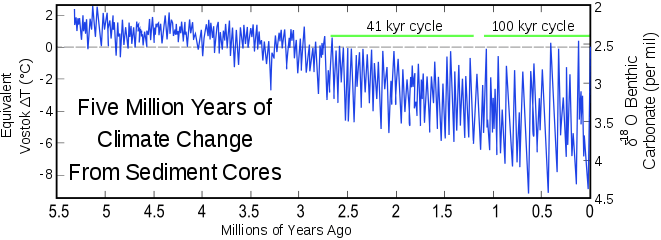
In fact, from 1–3 million years ago, climate cycles did match the 41,000-year cycle in obliquity. After 1 million years ago, the Mid-Pleistocene Transition (MPT) occurred with switch to the 100,000-year cycle matching eccentricity. The transition problem refers to the need to explain what changed 1 million years ago.[22] The MPT can now be reproduced in numerical simulations that include a decreasing trend in carbon dioxide and glacially induced removal of regolith.[23]
Interpretation of unsplit peak variances
Even the well-dated climate records of the last million years do not exactly match the shape of the eccentricity curve. Eccentricity has component cycles of 95,000 and 125,000 years. However, some researchers say the records do not show these peaks, but only show a single cycle of 100,000 years.[24]
Unsynced stage 5 observation
Deep-sea core samples show that the interglacial interval known as marine isotope stage 5 began 130,000 years ago. This is 10,000 years before the solar forcing that the Milankovitch hypothesis predicts. (This is also known as the causality problem, because the effect precedes the putative cause.)[25]
Predicted effects mystery
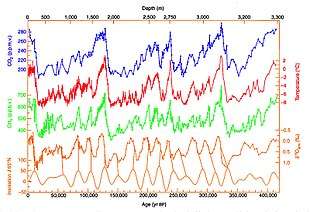
Physical evidence shows that the variation in Earth's climate is much more extreme than the variation in the intensity of solar radiation calculated as the Earth's orbit evolves. If orbital forcing causes climate change, science needs to explain why the observed effect is amplified out of linear proportion to the theoretical cause.
Some climate systems exhibit amplification (positive feedback) and others exhibit damping responses (negative feedback). As an illustration, if during an ice age the northern land masses were covered in year-round ice, solar energy would be reflected away, counteracting the eventual warming effect from orbital forcing and extending the ice age.
The Earth's current orbital inclination is 1.57° (see above). Earth presently moves through the invariable plane around January 9 and July 9. At these times, there is an increase in meteors and noctilucent clouds. If this is because there is a disk of dust and debris in the invariable plane, then when the Earth's orbital inclination is near 0° and it is orbiting through this dust, materials could be accreted into the atmosphere. This process could explain the narrowness of the 100,000-year climate cycle.[26][27]
Present and future conditions

Since orbital variations are predictable,[28] any model that relates orbital variations to climate can be run forward to predict future climate, with two caveats: the mechanism by which orbital forcing influences climate is not definitive; and non-orbital effects can be important (for example, the human impact on the environment principally increases greenhouse gases resulting in a warmer climate[29][30][31]).
An often-cited 1980 orbital model by Imbrie predicted "the long-term cooling trend that began some 6,000 years ago will continue for the next 23,000 years."[32] More recent work suggests that orbital variations should gradually increase 65° N summer insolation over the next 25,000 years.[33] Earth's orbit will become less eccentric for about the next 100,000 years, so changes in this insolation will be dominated by changes in obliquity, and should not decline enough to permit a new glacial period in the next 50,000 years.[34][35]
Effects on other celestial bodies
Other bodies in the Solar System undergo orbital fluctuations like the Milankovitch cycles. Any geological effects would not be as pronounced as climate change on the Earth, but might cause the movement of elements in the solid state.
Mars
Mars has no moon large enough to stabilize its obliquity, which has varied from 10 to 70 degrees. This would explain recent observations of its surface compared to evidence of different conditions in its past, such as the extent of its polar caps.[36][37]
Outer Solar system
Saturn's moon Titan has a cycle of approximately 60,000 years that could change the location of the methane lakes.[38][39] Neptune's moon Triton has a variation similar to Titan's, which could cause its solid nitrogen deposits to migrate over long time scales.[40]
Exoplanets
Scientists using computer models to study extreme axial tilts have concluded that high obliquity could cause extreme climate variations, and while that would probably not render a planet uninhabitable, it could pose difficulty for land-based life in affected areas. Most such planets would nevertheless allow development of both simple and more complex lifeforms.[41] Although the obliquity they studied is more extreme than Earth ever experiences, there are scenarios 1.5 to 4.5 billion years from now, as the Moon's stabilizing effect lessens, where obliquity could leave its current range and the poles could eventually point almost directly at the Sun.[42]
References
- Girkin, Amy Negich (2005). A Computational Study on the Evolution of the Dynamics of the Obliquity of the Earth (PDF) (Master of Science thesis). Miami University.
- Laskar, J; Fienga, A.; Gastineau, M.; Manche, H (2011). "La2010: A New Orbital Solution for the Long-term Motion of the Earth" (PDF). Astronomy & Astrophysics. 532 (A889): A89. arXiv:1103.1084. Bibcode:2011A&A...532A..89L. doi:10.1051/0004-6361/201116836.
- Berger A.; Loutre M.F.; Mélice J.L. (2006). "Equatorial insolation: from precession harmonics to eccentricity frequencies" (PDF). Clim. Past Discuss. 2 (4): 519–533. doi:10.5194/cpd-2-519-2006.
- Data from United States Naval Observatory
- van den Heuvel, E. P. J. (1966). "On the Precession as a Cause of Pleistocene Variations of the Atlantic Ocean Water Temperatures". Geophysical Journal International. 11 (3): 323–336. Bibcode:1966GeoJ...11..323V. doi:10.1111/j.1365-246X.1966.tb03086.x.
- Muller RA, MacDonald GJ (1997). "Spectrum of 100-kyr glacial cycle: orbital inclination, not eccentricity". Proc Natl Acad Sci U S A. 94 (16): 8329–34. Bibcode:1997PNAS...94.8329M. doi:10.1073/pnas.94.16.8329. PMC 33747. PMID 11607741.
- Kawamura K, Parrenin F, et al. (August 2007). "Northern Hemisphere forcing of climatic cycles in Antarctica over the past 360,000 years". Nature. 448 (7156): 912–6. Bibcode:2007Natur.448..912K. doi:10.1038/nature06015. PMID 17713531.
- Kerr RA (February 1987). "Milankovitch Climate Cycles Through the Ages: Earth's orbital variations that bring on ice ages have been modulating climate for hundreds of millions of years". Science. 235 (4792): 973–4. Bibcode:1987Sci...235..973K. doi:10.1126/science.235.4792.973. JSTOR 1698758. PMID 17782244./O
- Olsen PE (November 1986). "A 40-million-year lake record of early mesozoic orbital climatic forcing". Science. 234 (4778): 842–8. Bibcode:1986Sci...234..842O. doi:10.1126/science.234.4778.842. JSTOR 1698087. PMID 17758107.
- Hays, J. D.; Imbrie, J.; Shackleton, N. J. (1976). "Variations in the Earth's Orbit: Pacemaker of the Ice Ages". Science. 194 (4270): 1121–32. Bibcode:1976Sci...194.1121H. doi:10.1126/science.194.4270.1121. PMID 17790893. S2CID 667291.
- Nicholas Bakalar (2018-05-21). "Every 202,500 Years, Earth Wanders in a New Direction". New York Times. Retrieved 2018-05-25.
- Milankovitch, Milutin (1998) [1941]. Canon of Insolation and the Ice Age Problem. Belgrade: Zavod za Udz̆benike i Nastavna Sredstva. ISBN 978-86-17-06619-0.; see also "Astronomical Theory of Climate Change".
- Imbrie, John; Imbrie, Katherine P. (1986). Ice Ages: Solving the Mystery. Harvard University Press. p. 158. ISBN 978-0-674-44075-3.
- Shackleton, N. J.; Berger, A.; Peltier, W. R. (3 November 2011). "An alternative astronomical calibration of the lower Pleistocene timescale based on ODP Site 677". Transactions of the Royal Society of Edinburgh: Earth Sciences. 81 (4): 251–261. doi:10.1017/S0263593300020782.
- Abe-Ouchi A, Saito F, Kawamura K, Raymo ME, Okuno J, Takahashi K, Blatter H (August 2013). "Insolation-driven 100,000-year glacial cycles and hysteresis of ice-sheet volume". Nature. 500 (7461): 190–3. Bibcode:2013Natur.500..190A. doi:10.1038/nature12374. PMID 23925242.
- Rial, J.A. (October 2003), "Earth's orbital Eccentricity and the rhythm of the Pleistocene ice ages: the concealed pacemaker" (PDF), Global and Planetary Change, 41 (2): 81–93, Bibcode:2004GPC....41...81R, doi:10.1016/j.gloplacha.2003.10.003, archived from the original (PDF) on 2011-07-20
- Ghil, Michael (1994). "Cryothermodynamics: the chaotic dynamics of paleoclimate". Physica D. 77 (1–3): 130–159. Bibcode:1994PhyD...77..130G. doi:10.1016/0167-2789(94)90131-7.
- Gildor H, Tziperman E (2000). "Sea ice as the glacial cycles' climate switch: Role of seasonal and orbital forcing". Paleoceanography. 15 (6): 605–615. Bibcode:2000PalOc..15..605G. doi:10.1029/1999PA000461.
- Kevin Stacey (2017-01-26). "Earth's orbital variations and sea ice synch glacial periods". m.phys.org.
- Lee, Jung-Eun; Shen, Aaron; Fox-Kemper, Baylor; Ming, Yi (1 January 2017). "Hemispheric sea ice distribution sets the glacial tempo". Geophys. Res. Lett. 44 (2): 2016GL071307. Bibcode:2017GeoRL..44.1008L. doi:10.1002/2016GL071307.
- Wunsch, Carl (2004). "Quantitative estimate of the Milankovitch-forced contribution to observed Quaternary climate change". Quaternary Science Reviews. 23 (9–10): 1001–12. Bibcode:2004QSRv...23.1001W. doi:10.1016/j.quascirev.2004.02.014.
- Zachos JC, Shackleton NJ, Revenaugh JS, Pälike H, Flower BP (April 2001). "Climate response to orbital forcing across the Oligocene-Miocene boundary". Science. 292 (5515): 27–48. Bibcode:2001Sci...292..274Z. doi:10.1126/science.1058288. PMID 11303100. Archived from the original on 2017-12-03. Retrieved 2010-10-24.
- Brovkin, V.; Calov, R.; Ganopolski, A.; Willeit, M. (April 2019). "Mid-Pleistocene transition in glacial cycles explained by declining CO2 and regolith removal | Science Advances". Science Advances. 5 (4): eaav7337. doi:10.1126/sciadv.aav7337. PMC 6447376. PMID 30949580.
- "Nonlinear coupling between 100 ka periodicity of the paleoclimate records in loess and periodicities of precession and semi-precession" (PDF) – via ProQuest.
- Karner DB, Muller RA (June 2000). "PALEOCLIMATE: A Causality Problem for Milankovitch". Science. 288 (5474): 2143–4. doi:10.1126/science.288.5474.2143. PMID 17758906.
- Muller, Richard A; MacDonald, Gordon J. F. (1997). "Glacial Cycles and Astronomical Forcing". Science. 277 (5323): 215–8. Bibcode:1997Sci...277..215M. doi:10.1126/science.277.5323.215.
- "Origin of the 100 kyr Glacial Cycle: eccentricity or orbital inclination?". Richard A Muller. Retrieved March 2, 2005.
- F. Varadi; B. Runnegar; M. Ghil (2003). "Successive Refinements in Long-Term Integrations of Planetary Orbits" (PDF). The Astrophysical Journal. 592 (1): 620–630. Bibcode:2003ApJ...592..620V. doi:10.1086/375560. Archived from the original (PDF) on 2007-11-28.
- Harshit, H. P.; et al. (2009). "Recent Warming Reverses Long-Term Arctic Cooling". Science. 325 (5945): 1236–1239. Bibcode:2009Sci...325.1236K. CiteSeerX 10.1.1.397.8778. doi:10.1126/science.1173983. PMID 19729653.
- "Arctic Warming Overtakes 2,000 Years of Natural Cooling". UCAR. September 3, 2009. Archived from the original on 27 April 2011. Retrieved 19 May 2011.
- Bello, David (September 4, 2009). "Global Warming Reverses Long-Term Arctic Cooling". Scientific American. Retrieved 19 May 2011.
- J Imbrie; J Z Imbrie (1980). "Modeling the Climatic Response to Orbital Variations". Science. 207 (4434): 943–953. Bibcode:1980Sci...207..943I. doi:10.1126/science.207.4434.943. PMID 17830447. S2CID 7317540.
- "NOAA Paleoclimatology Program – Orbital Variations and Milankovitch Theory".
- Berger A, Loutre MF (2002). "Climate: An exceptionally long interglacial ahead?". Science. 297 (5585): 1287–8. doi:10.1126/science.1076120. PMID 12193773. S2CID 128923481.
- A. Ganopolski, R. Winkelmann & H. J. Schellnhuber (2016). "Critical insolation–CO2 relation for diagnosing past and future glacial inception". Nature. 529 (7585): 200–203. Bibcode:2016Natur.529..200G. doi:10.1038/nature16494. PMID 26762457.CS1 maint: uses authors parameter (link)
- Schorghofer, Norbert (2008). "Temperature response of Mars to Milankovitch cycles". Geophysical Research Letters. 35 (18): L18201. Bibcode:2008GeoRL..3518201S. doi:10.1029/2008GL034954. S2CID 16598911.
- "3.5 Modeling Milankovitch cycles on Mars (2010 – 90; Annual Symp Planet Atmos)". Confex.
- "Hydrocarbon lakes on Titan – Alex Hayes (SETI Talks)". YouTube.
- Nicholos Wethington (30 November 2009). "Lake Asymmetry on Titan Explained".
- "Sun Blamed for Warming of Earth and Other Worlds". LiveScience.com.
- Williams, D.M., Pollard, P. (2002). "Earth-like worlds on eccentric orbits: excursions beyond the habitable zone" (PDF). Inter. J. Astrobio. 1 (1): 21–9. Bibcode:2002IJAsB...1...61W. doi:10.1017/s1473550402001064.CS1 maint: multiple names: authors list (link)
- Neron de Surgy, O.; Laskar, J. (February 1997), "On the long term evolution of the spin of the Earth", Astronomy and Astrophysics, 318: 975–989, Bibcode:1997A&A...318..975N
Further reading
- The oldest reference for Milankovitch cycles is: Milankovitch, M. (1930). Mathematische Klimalehre und Astronomische Theorie der Klimaschwankungen. Handbuch der Klimatologie. 1 Teil A. von Gebrüder Borntraeger. OCLC 490063906.
- Roe G (2006). "In defense of Milankovitch". Geophysical Research Letters. 33 (24): L24703. Bibcode:2006GeoRL..3324703R. doi:10.1029/2006GL027817. S2CID 13230658. This shows that Milankovitch theory fits the data extremely well, over the past million years, provided that we consider derivatives.
- Kaufmann R. K.; Juselius K. (2016), "Testing competing forms of the Milankovitch hypothesis", Paleoceanography, 31 (2): 286–297, Bibcode:2016PalOc..31..286K, doi:10.1002/2014PA002767.
- Edvardsson S, Karlsson KG, Engholm M (2002). "Accurate spin axes and solar system dynamics: Climatic variations for the Earth and Mars". Astronomy and Astrophysics. 384 (2): 689–701. Bibcode:2002A&A...384..689E. doi:10.1051/0004-6361:20020029. This is the first work that investigated the derivative of the ice volume in relation to insolation (page 698).
- Zachos J, Pagani M, Sloan L, Thomas E, Billups K (2001). "Trends, Rhythms, and Aberrations in Global Climate 65 Ma to Present". Science. 292 (5517): 686–693. Bibcode:2001Sci...292..686Z. doi:10.1126/science.1059412. PMID 11326091. S2CID 2365991.
This review article discusses cycles and great-scale changes in the global climate during the Cenozoic Era. - Pälike, H., R.D. Norris, J.O. Herrle, P.A. Wilson, H.K. Coxall, C.H. Lear, N.J. Shackleton, A.K. Tripati, and B.S. Wade (2006). "The Heartbeat of the Oligocene Climate System" (PDF). Science. 314 (5807): 1894–8. Bibcode:2006Sci...314.1894P. doi:10.1126/science.1133822. PMID 17185595.
A 13-million-year continuous record of Oligocene climate from the equatorial Pacific reveals a pronounced "heartbeat" in the global carbon cycle and periodicity of glaciations.
CS1 maint: uses authors parameter (link)
External links
![]()
![]()
- Ice Age – Milankovitch Cycles – National Geographic Channel
- The Milankovitch band, Internet Archive of American Geophysical Union lecture
- Campisano, C. J. (2012) Milankovitch Cycles, Paleoclimatic Change, and Hominin Evolution. Nature Education Knowledge 4(3):5